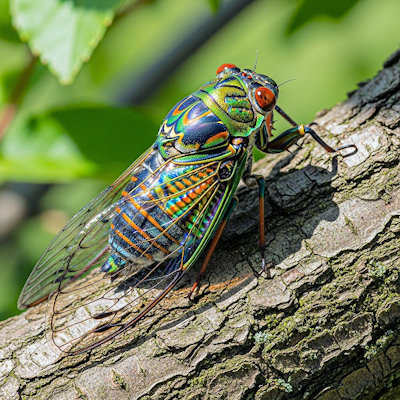Cicada in Provence, France
The cicada should be on the flag of Provence, as it truly embodies the spirit of the region's hot, sunny summers. These buzzing insects are a real symbol of southeastern France, famous for their rhythmic and loud song echoing across the countryside during the scorching months.
What you’ll mostly spot, though, are the decorative versions — sold in almost every souvenir shop. Made from a variety of materials and painted in bright colors, they’re far more attractive than the real ones. Actual cicadas are grey, not very pretty, and excellent at hiding. Even though they measure 2–3 cm in length, they blend perfectly with tree bark and are incredibly hard to notice — a clever natural camouflage against predators.
Cicadas start to sing when the temperature reaches around 22–24°C, and their chorus continues until sunset. That said, we once heard a rebel cicada chirping even after the sun had disappeared below the horizon — determined little creature!
So why do cicadas sing? Great question. Only male cicadas produce those piercing sounds, and it’s all about attracting a mate. Their rapid-fire muscles and built-in amplifier system help them reach volumes exceeding 100 dB — that’s as loud as a chainsaw or a motorcycle without a muffler! Now imagine dozens of them singing at once... Locals tend to find the sound quite irritating (unlike tourists, who find it charming). And honestly — would you enjoy hearing that buzz from May to October every single year? You can hear it yourself in our video.

Cicadas thrive in Provence’s hot and dry Mediterranean climate. They are especially common in rural areas, where their sound pierces through the rustle of trees and other background noises. Spending most of their life in trees, they feed on plant sap and are active mainly during the day.
Yet not all is idyllic: cicadas can be a threat to another Provençal icon — lavender. A small species called the cicadelle lays its eggs just below the soil near lavender roots. These larvae and adults feed on the plant’s sap and also spread a bacterium called stolbur phytoplasma, which causes lavender to gradually wither and die.
In Provençal folklore, cicadas are a joyful symbol of summer and the zest for life. Their song is considered a celebration of nature and sunshine, representing the endurance needed to survive Provence’s harsh heat.
Cicadas have inspired artists and writers for centuries. You’ll find their images on everything from traditional ceramics and fabrics to modern paintings and sculptures.
All in all, the cicada is deeply woven into Provençal culture — a living soundtrack of summer and a lasting emblem of the region’s rhythm and lifestyle.
Interestingly, cicadas spend most of their lives underground — some species can stay there for several years before finally emerging to sing, mate, and complete their brief cycle above ground. Their patience is impressive... and noisy.
See also:
